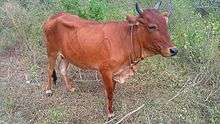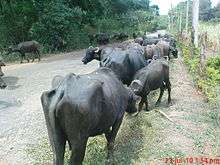Livestock in Sri Lanka
In Sri Lanka many farmers depend on animal husbandry for their livelihood, but not a large proportion. Therefore, many livestock products have to be imported. The main livestock products in Sri Lanka are milk, meat and eggs. Hides, wools and other products are still not produced within the country. Animal power formerly used in the cultivation of rice and vegetables has been replaced by modern technology to farm lands. However animal husbandry plays an important role in the rural economy for improving the living conditions of farmers in the country.
The land area of Sri Lanka is 65,610 km2. and of this, 30% belongs to agricultural activities. From that 30%, 70% is solely devoted to crop production. The remainder consists of a mixture of crops and livestock. Hence, a very small proportion of the farm land is solely devoted to livestock production. In Sri Lanka, livestock sector contributes around 1.2% of national GDP. Livestock are spread throughout all regions of Sri Lanka with concentrations of certain farming systems in particular areas due to cultural, market and agro-climatic reasons. According to statistics from the Department of Animal Production and Health, there are about 1.3 million cattle, 0.3 million buffalo, 0.4 million goats, 13 million poultry and 0.08 million pigs in the country with negligible numbers of sheep, ducks and other animal breeds.[1]
Consumption of meat and dairy products
The per capita consumption of milk and dairy products in Sri Lanka (about 36 kg) is less, compare to other countries in South Asian region. Since 1980's Sri Lanka import dry milk powder as their main dairy commodity from Australia and New Zealand up to now.
Main dairy/meat products
A very few types of dairy products are locally processed by a few companies as well as house hold producers in the country. The most leading product among them is yoghurt and hundreds of trade names are available to buy it. Other main dairy products are ice cream, curd, ghee, liquid milk (pasteurized and flavoured), cheese and some sweets.
Livestock Breeds
Domestic breeds are rarely used as a livestock breed in Sri Lanka. Large portion of livestock breeds are cross or introduced breeds. Because local breeds have poor productive ability and improper quality of milk and meat .
Cattle

There are few breeds of dairy cattle used for milk production. The selection of a cattle breed largely depends on the bio-climatic condition in the region. European breeds are recommended for upcountry wet and intermediate zones, while Indian breeds are recommended for low country dry and intermediate zones. There are also cross breeds for the low country wet zone.
Cattle breeds for up country
Cattle breeds for low country
- Sindhi
- Sahiwal
- Tharparkar (cattle)
- AMZ ( Australian Milking Zebu )
- AFS ( Australian Frisian x Sahiwal )
- Local crossbreds ( "Indigenous" or "native" "local" is no longer valid they are cross breds of indegenoues Catttleattle with Indian (bos indicus breeds and mostly found in the dry zone of Sri Lanka. True indigenous breed of local cattle was extinct in late 1930's. Recently they have been called as "Lankan Cattle, But not true Lankan cattle .)
With the exception of a few breeds, most of the dairy breeds can be utilized in most bio-climatic areas providing that the level of management is high and the availability of quality fodder is well planned. The Australian Frisian x Sahiwal has not met the expectations of a tropical dairy breed.
Cattle breeds for Mid country
Hatton cow or Cape cattle a good milking breeds available before the milk present exotic breeds were popularize presently extinct.
Local breed Thamankaduwa White Cattle confined to Eastern part of the island
Cattle breeding
The main cattle breeding method is using Artificial insemination (AI), which covers approximately 60% and Natural Breeding using improved breeds of stud bulls is practiced in remote areas and it covers approximately 25% of the total. Artificial Insemination (AI) is being practiced using locally produced semen and a limited amount of imported semen.
There are two AI Stations available in Sri Lanka, namely Central Artificial Insemination Station (CAIS) situated in Kundasale, in Kandy district and Artificial Insemination Station situated at Kaduruwela, Polonnaruwa.
Buffalo Breeds


Water buffaloes are reared for draught and milk production. Local buffaloes produce low milk yield and in the rural sector they mainly kept for power in rice cultivation to plough and harrow the fields. Introduced Indian breeds are mainly kept for milk production and for cross breeding with local buffaloes for upgrading. Large portion of water buffalo milk is used for curd and ghee production. Water buffalo meat is not very popular within Sri Lanka and is legally banned for slaughter.
- Niliravi
- Murrah
- Surti(Pure bloodlines cannot be found in Sri Lanka at present. They are mixed with other breeds of buffaloes
These three Indian breeds are Riverine type water buffaloes they prefer clear water to wallow.
- Domestic buffalo (Phenotypically swamp type (prefer mud puddles for wallowing), but genetically riverine)
Goat Breeds available in Sri Lanka
- Saanen- for milk production
- Jamnapari - for meat and milk
- Crosses of Jamnapari & Saanen - for meat and milk
- Boer imported from Germany for cross breeding with Jamnapari or Kottukachchiya breed to establish a new synthetic breed called Sri Lankan Boer
- Nondiscript local crossbreds (local breed) - meat
- Crosses of Jamnapari,Saanen x Local breed - meat
Goat Breeding Farms
- Thelahera Goat Breeding Farm in Kurunegala District, Imbulandanda Goat Breeding Farm in Matale district of Department of Animal Production & Health (DAP&H).
Breed - Jamnapari, (Original herd imported from India in year 1997 by ministry of Livestock and Rural Industrial Development.)
- Bopatahlawa Farm in Nuwara Eliya district and Mahaberiyatenna Farm in Kandy district of The National Livestock Development Board (NLDB).
Breed - Saanen (Original herd Imported from The Netherlands)
Other Goat breeds previously available in Sri Lanka but presently vanished
- Kottukachchiya - Synthetic breed developed in late 1960,s for meat
- Beetal - for milk and meat
- German Boer - meat
- Sri Lanka Boer (German Boer X Kottukachchiya / Jamnapari) - meat
- German fawn - milk and meat
- Akyub extinct breed recorded in literature found in Jaffna Peninsula believed to be brought from Burma (Myanmar)
Sheep breeds
- Jaffna Local
- Bikenary
- Bannur
- Red Madras
- Dorset
All above breeds are kept for meat. Present the few insignificant number found are all crossbreds.
Previously Operated Goat & Sheep Breeding Farms
- Kottukachchiya Farm - DAP&H, SRL / GTZ Goat Development Project. - Goat Breeding
- Weerawila and Ridigama in the Southern Province
- Boralanda Farm - DAP&H - Sheep Breeding
Pig breeds
- local landrace / "mini pigs" - extensively managed / Scavenging
Exotic Breeds raised about 40 years ago
- Berkshire
- Yorkshire
- Large Black
- Blue Pigs (Large White X Large Black)
Present day Exotic breeds
References
- ↑ "Livestock Statistics (Sri Lanka)". http://www.daph.gov.lk. Archived from the original on March 2, 2009. Retrieved 2009-07-11. External link in
|publisher=(help)